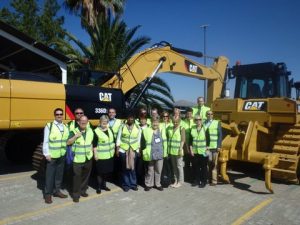Our two site visits today capped our business experiences in Namibia, and summed up a number of themes we’d heard elsewhere.
The first was to the local Caterpillar dealer, and though I had visited a number of Cat facilities in Asia, I had never visited a dealer before. The dealer was part of a chain that a number of south African countries from headquarters in Johannesburg. There is kind of a love-hate relationship, I realized, between Namibians and South Africans. In addition to the over 25 year civil war to create an independent Namibia from an administered province of South Africa, there is much economic dependence today, partly because Namibia is a country of only 2.5 million people, or about the size of Naperville (actually it is larger than Naperville, but you know what I mean). Because of the mining and the road construction here, this could be a good market for Caterpillar. And in some areas it is. Some of the big mines (including the Chinese-owned one) are big purchasers of Caterpillar equipment. One major drawback, however, is that there is a tariff of 14% on imported goods, and there is an African company with a joint venture with John Deere that is considered African—hence, its products are tariff free. Small wonder Cat champions free trade.
Despite the price disadvantage, Cat sells well because of reliability and maintenance. Over half the company’s employees are assigned to work at various mines to service equipment. We toured the warehouse and maintenance facilities, where the tractor used to move equipment was a 1963 model, which ought to say something about durability. The business suffers from several other drawbacks as well: currency risk (i.e., when you bill in dollars and collect in Namibian dollars the exchange rate is critical on big ticket items—and Caterpillar products are big and big ticket—especially when those items cost $15-$25 million dollars; the dealer writes local contracts in Namibian dollars with the proviso that the price is subject to the exchange rate. The products are all manufactured overseas and assembled in Namibia (or elsewhere). 20% of the equipment is leased. Finally, sales depend on industry expectations, which in turn, depend on commodity prices, which right now are down.t
What I gathered is that being a franchised dealer means (among other things) that Cat supplies promotional materials, performance metric standards, and training—as well as the products. The metrics include customer satisfaction and plant safety—the latter was one of the sources of the manager’s pride—0.25 accidents over the last 4 months. As I pointed out when we left, people come to the Namibian game preserves to see the Big 5 animals (lions, etc.)—we had seen the “Big Cat,” and if they wanted to use that as part of their advertising, I’d be glad to talk with them about signing away my rights!
She also revealed something I had not realized. When Namibia voted on UN Resolution 435 in 1990 (the US brokered a deal in which South Africa withdrew from Namibia and Cuba withdrew from Angola/Namibia (which accounts for the Cold War battles fought here in the 70s and 80s, and the suspicion of the United States by that generation), the country consciously chose English as the national language rather than the other competitors (German, Afrikaan, the 13 tribal languages), making English a foreign language. She said that at the primary and secondary levels, though, it’s still not taught universally.
A visit to the Ambassador’s house for a reception capped our day and our business visits in Namibia. It was fitting, because also attending were many of the speakers we’d met, and movers and shakers from government (several ministers and the president pro-tem) and business. We spent a very pleasant evening meeting and spending some time talking with individuals from various background who were essentially curious about what we saw, thought, and expected from our visit to Namibia.
I think I’ve shared my thoughts on the topic with you.
I don’t think I want to be the ambassador, but I certainly loved his house, which, as a taxpayer, I do own.
On to Scout camp—er, Etosha National Park.



